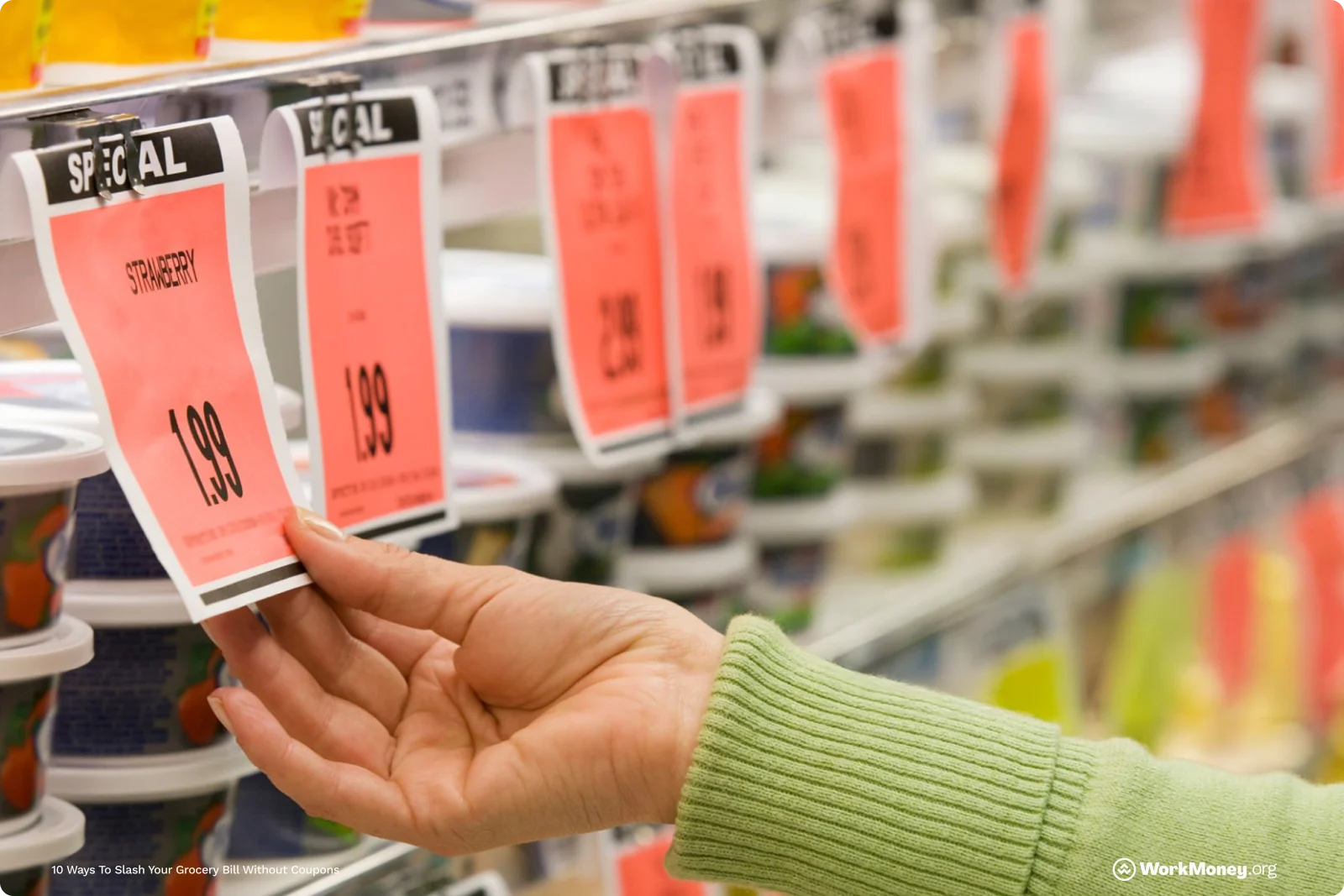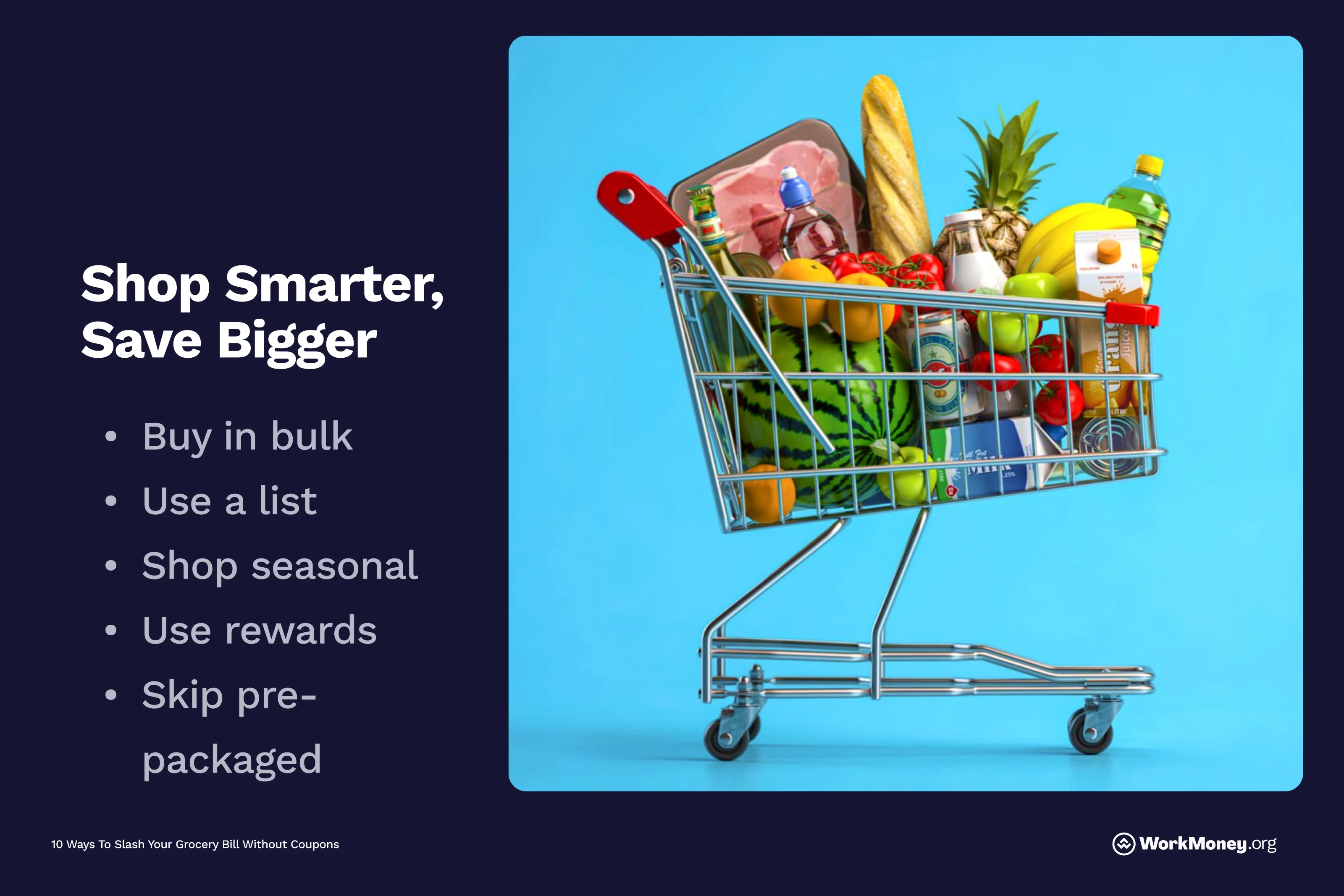10 Ways To Slash Your Grocery Bill Without Coupons
Skip the coupons—these smart, easy tips will help you cut your grocery bill without the extra hassle.

Saving money on groceries doesn’t have to mean clipping coupons or chasing sales. While coupons can help, they’re often time-consuming and limited to specific products. If you’re looking for ways to cut your grocery bill significantly without relying on coupons, you’re in the right place. Here are some ways to help you save more at the checkout line.

1. Planning is Everything
Walking into a grocery store without a plan can quickly turn into grabbing random items that cost you more than you would like. Even if you have several social media videos saved with recipes you want to make, having a detailed list will keep your trip organized and within your budget.
2. Buy in Bulk
Bulk shopping is a great way to save money when done with a plan. Sometimes, it can be done with the idea of saving money, but still end up costing the same (or even more) than buying in smaller amounts.
When buying in bulk, focus on non-perishable staples like rice, beans, pasta, and canned goods. If you purchase meat in bulk, divide it up and freeze it for future meals.
3. Stick to Store Brands
More everyday stores are introducing their own brands, known as private-label brands. Popular private-label brands include Target’s Good & Gather and up&up, Walmart’s bettergoods, and Costco’s Kirkland Signature. These brands offer shoppers nearly identical products for less when compared to national brands. In fact, more shoppers are opting to buy store brands to save.
The next time you visit a store with a private label brand, visit the laundry detergent aisle. You will find a large price difference between the national and private-label brands for basically the same product.
One store famous for this is Aldi. The brand focused on selling private label brands so it can keep prices low for consumers. This is an easy way to save without sacrificing on quality.
To save even more, consider using apps like Instacart and Upside to get offers on your everyday grocery needs, and even free delivery.
4. Shop Seasonally and Locally
The price of fruits and vegetables can go up and down regularly based on seasons. When they aren’t in season, they can often cost more as supply is lower.
Here’s a list of popular fruits and vegetables and when they are in and out of season.
Season | In Season | Out of Season |
|---|---|---|
Spring | Fruits: Strawberries, Pineapple, Mango, Kiwi, Apricots Vegetables: Asparagus, Peas, Artichokes, Radishes, Spinach | Fruits: Apples, Pears, Grapes, Watermelon Vegetables: Tomatoes, Potatoes, Sweet Potatoes |
Summer | Fruits: Watermelon, Peaches, Blueberries, Raspberries, Cherries, Blackberries, Plums Vegetables: Tomatoes, Zucchini, Bell Peppers, Cucumbers, Corn, Green Beans | Fruits: Apples, Pears, Cranberries Vegetables: Cauliflower, Brussels Sprouts, Pumpkins |
Fall | Fruits: Apples, Pears, Cranberries, Grapes, Pomegranates, Figs Vegetables: Pumpkins, Squash, Sweet Potatoes, Brussels Sprouts, Cauliflower | Fruits: Strawberries, Peaches, Cherries Vegetables: Cucumbers, Tomatoes |
Winter | Fruits: Oranges, Clementines, Grapefruit, Persimmons, Pomegranates Vegetables: Kale, Cabbage, Leeks, Potatoes, Carrots, Beets | Fruits: Watermelon, Blueberries, Raspberries Vegetables: Zucchini, Bell Peppers, Spinach |
Additionally, check your local farmers’ market for deals on produce, and consider frozen fruits and vegetables when they are out of season.
5. Avoid Pre-Packaged and Processed Foods
There are plenty of options to cut down on the work of grocery prep. For example, you can buy shredded cheese, pre-cut potatoes, and sliced apples. However, these are more expensive compared to the non-prepared options.
Stay clear away from pre-cut vegetables, shredded cheese, and frozen meals. Opt to cook from scratch and take on the effort to save more money.
6. Use Cash-Back and Rewards Programs
This takes some planning, but there are plenty of cash back apps like Upside to help you save money on your grocery bill. Additionally, many grocery stores offer loyalty programs where you can earn points to redeem for money off of your bill.
In certain circumstances, it can make sense to use apps like Instacart. With promo codes and seasonal promotions, it could be worth it to have your groceries delivered.
7. Limit Grocery Store Trips
The more often you shop, the more likely you are to make impulse purchases. Be diligent about limiting your time in the grocery store, as well as the amount of trips you make.
8. Be Mindful of Sales Gimmicks
Just like any other business, grocery stores use clever marketing tactics to encourage you to spend more. For example, if you see a “10 for $10” deal, you may not need to buy all 10 to qualify for each item to be $1 each.
Also, look carefully at the unit price. This means looking at the price per ounce or pound of each product to ensure you’re getting the best deal.
9. Make Smart Beverage Choices
Drinks can eat up a large chunk of your grocery budget, often without you realizing it. Instead of buying pre-made canned drinks, opt to make your own drinks at home. For example, instead of buying a jug of premade coffee or tea, make it yourself to save even more.
10. Utilize Leftovers and Reduce Food Waste
Food waste is essentially throwing money away. Finding ways to use all your groceries can save you a surprising amount over time.
Store food properly to keep it fresh longer.
Freeze leftovers instead of letting them go bad.
Get creative with meals—use vegetable scraps for broth or leftover meat for sandwiches.
Final Thoughts
You don’t need coupons to slash your grocery bill. With smart shopping habits, meal planning, and a focus on fresh, affordable ingredients, you can significantly cut costs without sacrificing quality. By making a few strategic changes to the way you shop and eat, you can save hundreds of dollars each year—all without ever clipping a coupon.
About the Author

Brett Holzhauer
Brett Holzhauer is a Certified Personal Finance Counselor (CPFC) who has reported for outlets like CNBC Select, Forbes Advisor, LendingTree, UpgradedPoints, MoneyGeek and more throughout his career. He is an alum of the Walter Cronkite School of Journalism at Arizona State. When he is not reporting, Brett is likely watching college football or traveling.

